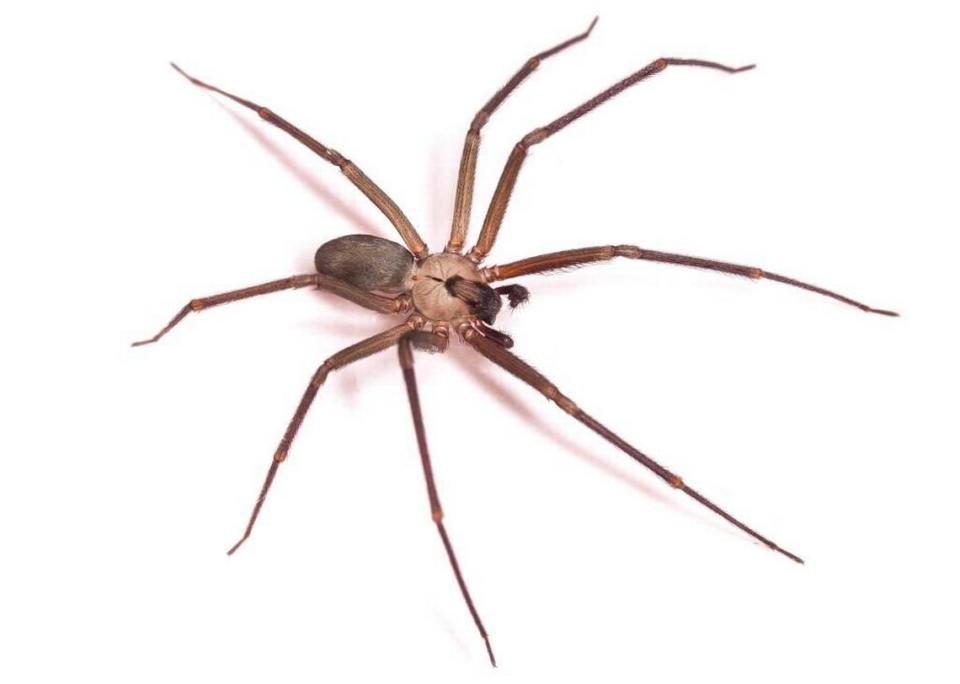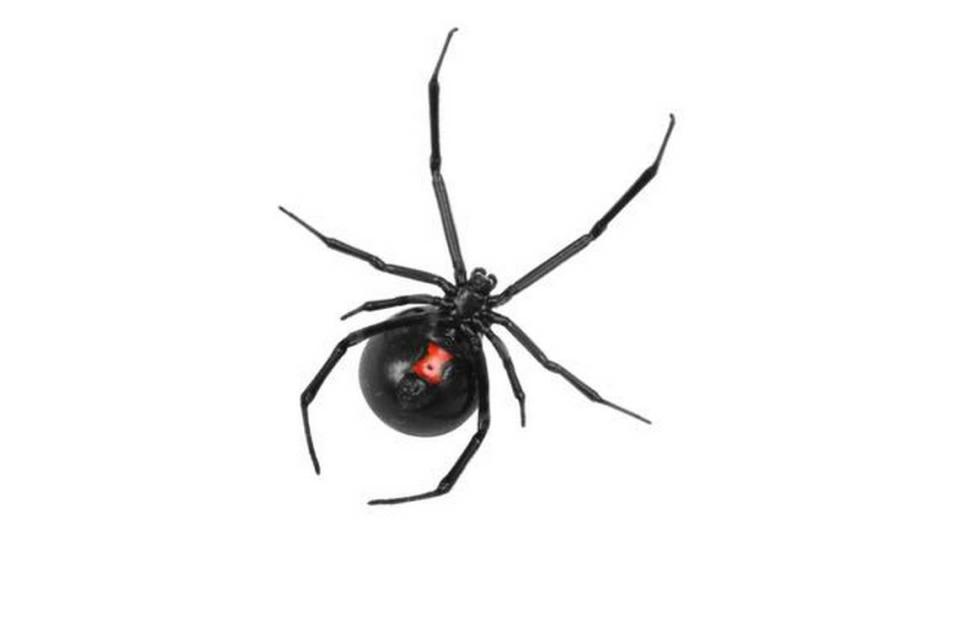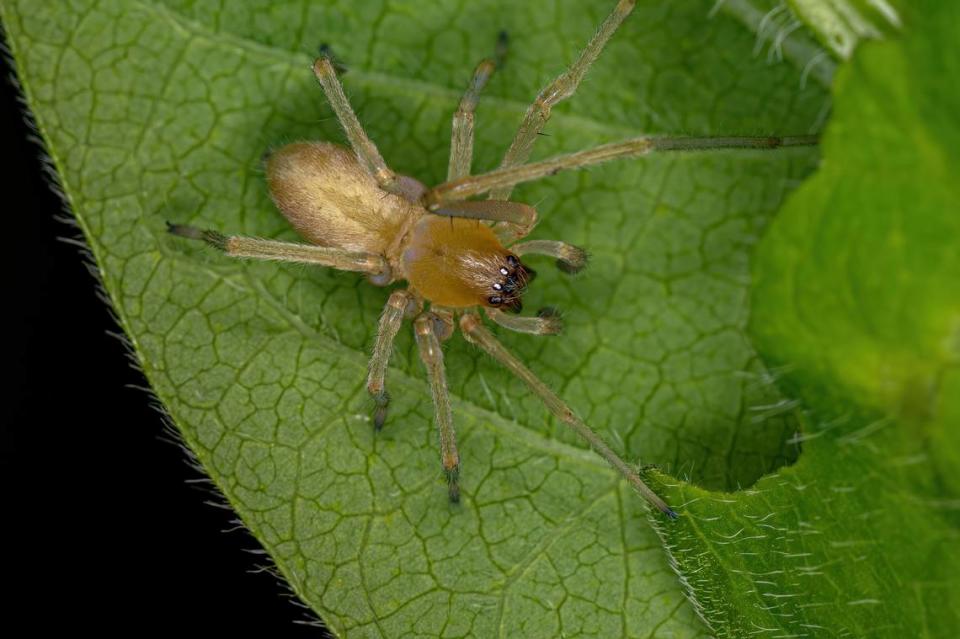Kansas is home to 3 dangerous spiders. Here’s how to spot and avoid the creepy crawlers
Even if you don’t see them, spiders are a common cohabitant in Kansas homes.
But more likely than not, they are harmless and won’t bite you unless provoked. While most spiders carry some sort of venom, most of the venom isn’t enough to be dangerous to humans.
“There’s really only three spiders that have, like, [a] detrimental or any sort of effect on humans,” Daren Riedle, diversity wildlife coordinator with the Kansas Department of Wildlife and Parks, told The Eagle. “Just about all spiders are venomous, they use venom to help subdue their prey. In most cases they are either too small to even bite a person or their venom is too weak you would never [notice] an effect at all.”
Riedle said there are three notable “dangerous” spiders in Kansas — the brown recluse, black widow and the yellow sac spider. Here’s what to know about identifying them.
Brown recluse

The most common dangerous spider in Kansas, the brown recluse can be found in pretty much every home, Riedle said. Like most spiders though, brown recluses usually only bite when provoked.
“Most of the time it’s, you know, if you roll over on them in your sleep or put a shoe on or something. In most cases it’s a defensive bite,” Riedle said.
Scientific name loxosceles reclusa, brown recluses are known for their brown or tan bodies, and have legs the same color. They have very thin hairs that cover their bodies but not their legs. According to pest company Terminix, they are usually found in undisturbed places, like sheds, barns and wood piles.
Riedle noted there’s some debate on how prominent brown recluse bites are, and when it comes to severity, bites differ.
“[In] some people, they can have serious necrotic effect. Some people can have mild to no effect at all,” Riedle said.
Getting bitten by a brown recluse is usually painless because of the size of the spider’s fangs, according to Healthline, a media platform focused on medical news. About two to eight hours after the initial bite, it’s common to notice inflammation and redness around the area. Bites usually look like two puncture holes with a white center.
In most cases, the bite is completely healed in three weeks but in some serious cases, the bite area can develop dead tissue. Severe reactions to brown recluse bites include, according to Healthline:
Vomiting
Fever
Dizziness
Chills
Treatment for the bites depend on the severity of the case. When bitten, Healthline recommends you:
Ice the area for 10 minutes at a time
Elevate the bitten area
Take anti-inflammatories
Get an up-to-date tetanus shot
If your case is severe, doctors may prescribe antibiotics or do more serious treatment, like skin grafts if the skin is severely affected. If you feel you may be having a severe reaction, see your health care provider to limit the need for severe forms of treatment.
Black widow

Scientific name latrodectus mactans, black widow spiders can usually be identified by the red hourglass marking on their back. While they are usually black, females can also be a brownish color, according to the National Pest Management Association.
Black widow bites are very rare, Riedle said.
“The female black widows tend to build a nest, build their web and stay there,” Riedle said. “You see them a lot in old barns, around old wood and stuff.”
However, when they do bite, the cases can be severe.
“In most cases, black widow bites can be very serious, they have a very neurotoxic venom,” the wildlife coordinator noted.
While severity varies, you can experience pain from a bite immediately, Healthline says. The bite area will turn red and begin to swell, and other, more severe symptoms will usually begin a few hours later. Pain can be felt in the chest and abdomen, and maybe in the shoulders and back.
Other possible symptoms include, from Healthline:
Nausea
Chills
Weakness
Fever
Headache
Difficulty breathing
If you think a black widow has bitten you, you should seek medical care right away. Treatment varies, but some possible methods include pain medication, muscle relaxants, antivenom and more.
As soon as you believe you’ve been bitten, Healthline recommends washing the bite with soap, icing the area and elevating the bite.
Yellow sac spider

The third dangerous spider in Kansas is the yellow sac spider, scientific name cheiracanthium inclusum. This creature can be identified by its pale yellow/green color.
“Their bite is not supposed to be as bad as the others,” Riedle said.
These spiders are usually found outdoors, in bushes, leaves, trees and woodpiles, according to Hawx Pest Control. Like all spiders, these can be found indoors searching for food when the weather becomes cooler.
Their bite usually presents itself as two spots, where the fangs damaged the skin. The bite area can be a yellow/green color and symptoms usually start to appear four to eight hours later, according to the University of Nebraska Department of Entomology. Symptoms can include nausea, vomiting and a headache, as well as the area of the bite swelling and becoming painful and itchy.
Like all spider bites, you should wash it with soap and water and seek medical care if symptoms are severe.

